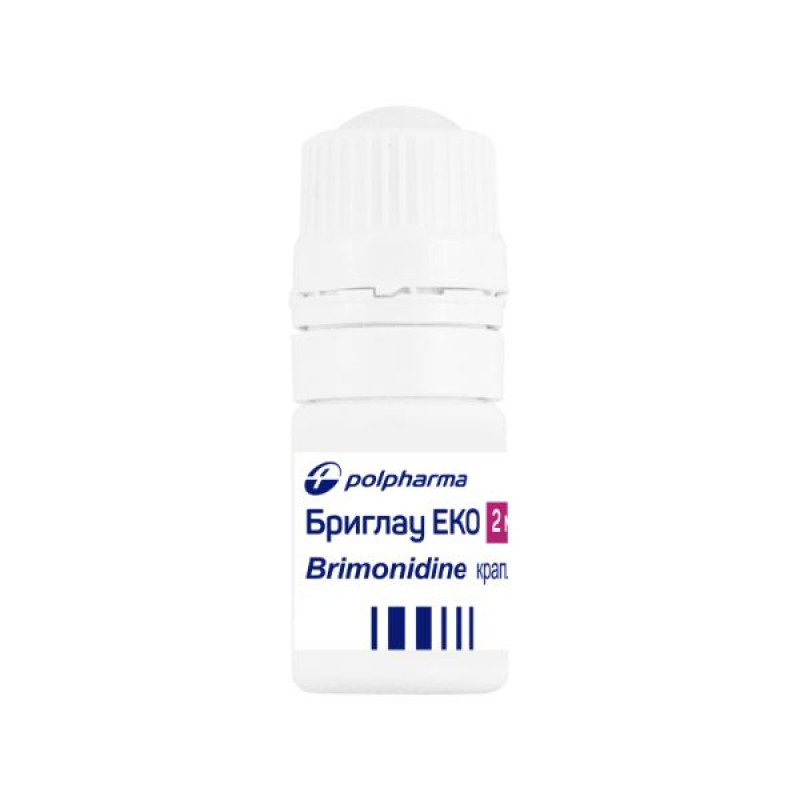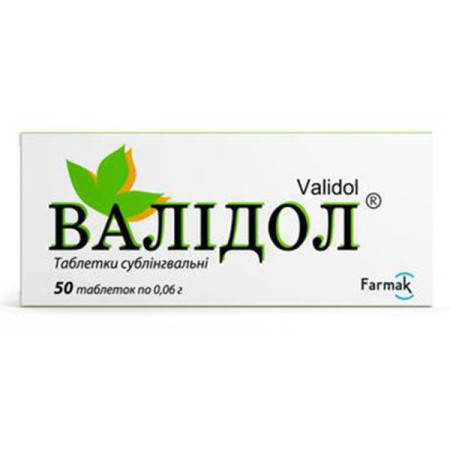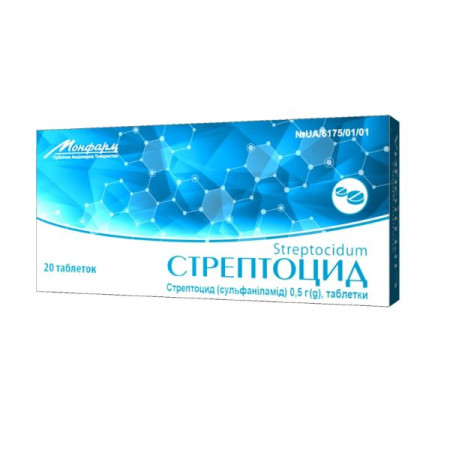Briglau Eco eye drops solution 2 mg/ml dropper bottle 5 ml

Instructions for use Briglau Eco eye drops solution 2 mg/ml dropper bottle 5 ml
Composition
active ingredient: brimonidine tartrate;
1 ml of solution contains brimonidine tartrate 2 mg;
excipients: polyvinyl alcohol 40-88; sodium citrate; citric acid, monohydrate; sodium chloride; diluted hydrochloric acid, 10% solution; sodium hydroxide, 10% solution; purified water.
Dosage form
Eye drops, solution.
Main physicochemical properties: transparent, yellow-green solution.
Pharmacotherapeutic group
Antiglaucoma and miotic agents. ATX code S01E A05.
Pharmacological properties
Pharmacodynamics
Brimonidine is an α-2-adrenergic receptor agonist. Brimonidine has a 1000-fold greater affinity for α-2-adrenergic receptors than for α-1-adrenergic receptors. As a result, brimonidine does not cause mydriasis or capillary stenosis in human retinal xenografts.
In humans, brimonidine tartrate, after administration into the conjunctival sac, reduces intraocular pressure with minimal effect on the cardiovascular and respiratory systems.
Limited data on the use of the drug in patients with bronchial asthma have not confirmed the occurrence of side effects.
Brimonidine has a rapid onset of action, with peak hypotensive effect occurring 2 hours after administration. In two clinical trials conducted over a period of one year, brimonidine reduced intraocular pressure by approximately 4–6 mm Hg.
Based on fluorophotometric studies in animals and humans, brimonidine tartrate appears to have a dual mechanism of action. Brimonidine is believed to reduce intraocular pressure by reducing aqueous humor synthesis and increasing uveoscleral outflow.
Clinical studies confirm that brimonidine can be effectively combined with topical beta-blockers. Short-term clinical studies also confirm that brimonidine has a significant clinical additive effect in combination with travoprost (6 weeks) and latanoprost (3 months).
Pharmacokinetics
After 10 days of instillation of a 0.2% solution into the conjunctival sac twice daily, low plasma concentrations of brimonidine were observed (Cmax averaged 0.06 ng/mL).
After repeated administration (2 times a day for 10 days), a small accumulation of the drug in the blood was observed. The area under the pharmacokinetic curve "concentration - time" for 12 hours at steady state (AUC0-12h) was 0.31 ng h/ml compared to 0.23 ng h/ml after the first dose. The average half-life from the general circulation after topical administration of the drug was approximately 3 hours.
After topical administration, brimonidine is approximately 29% bound to plasma proteins.
Brimonidine binds reversibly to melanin in ocular tissues in vitro and in vivo. After 2 weeks of topical application, brimonidine concentrations in the iris, ciliary body, and choroid/retinal membranes were 3-17 times higher than after a single dose. No accumulation of the drug was observed in the absence of melanin.
The significance of melanin binding in humans has not been studied. However, no adverse ophthalmological side effects were confirmed in biomicroscopic examinations of the eyes of patients treated with brimonidine for up to 1 year. No signs of ocular toxicity were also confirmed in animal studies administered brimonidine tartrate for one year at doses 4 times the recommended human dose.
After oral administration to humans, brimonidine is rapidly absorbed from the gastrointestinal tract and then rapidly eliminated from the body. A significant portion of the dose (approximately 75%) is excreted as metabolites in the urine within 5 days; no unchanged drug is detected in the urine. In vitro studies using animal and human liver tissue indicate that the metabolic changes of brimonidine occur primarily with the participation of aldehyde oxidase and cytochrome P450. Therefore, hepatic metabolism is the main route of elimination of the drug from the general circulation.
Kinetic profile
No significant deviations from the proportional relationship between brimonidine dose, maximum plasma concentration Cmax and AUC were found after a single administration of the drug at a concentration of 0.08%, 0.2% and 0.5%, respectively.
Elderly patients
Cmax, AUC and half-life of brimonidine after a single dose are similar in elderly patients (aged 65 and over) and young patients. These observations indicate that there is no relationship between age and drug absorption into the general circulation, as well as its elimination.
Clinical studies lasting 3 months (in elderly patients) confirmed that the overall effect of brimonidine was very small.
Indication
Use to reduce elevated intraocular pressure in patients with open-angle glaucoma or elevated intraocular pressure:
In monotherapy, if topical beta-blockers are contraindicated. In combination therapy with other drugs that reduce intraocular pressure, if the pressure reduction with the use of these drugs is insufficient.
Contraindication
Hypersensitivity to brimonidine tartrate or to any of the other ingredients of the drug. Children (under 18 years of age). Contraindicated in patients receiving treatment with monoamine oxidase inhibitors (MAO) and antidepressants that affect noradrenergic transmission (e.g. tricyclic antidepressants and mianserin).
Interaction with other medicinal products and other types of interactions
Briglau EKO is contraindicated in patients receiving treatment with MAO inhibitors and in patients taking antidepressants that affect noradrenergic transmission (i.e. tricyclic antidepressants and mianserin).
Despite the lack of special studies of drug interactions with Briglau EKO, the possibility of enhancing the effect of drugs that depress the central nervous system (alcohol, barbiturates, opium derivatives, sedatives, general anesthetics) should be taken into account.
The drug should be prescribed with caution to patients taking medications that may affect the metabolism of amines and their distribution in the vascular bed, such as chlorpromazine, methylphenidate, reserpine.
After the use of brimonidine, a decrease in arterial blood pressure was observed in some patients, which was not clinically significant. Hypotensive drugs and cardiac glycosides should be prescribed with caution.
Caution should be exercised when using brimonidine concomitantly with antihypertensive drugs and/or cardiac glycosides. Caution should also be exercised when initiating (or changing the dose of) a systemic drug (regardless of pharmaceutical form) that may interact with or affect α-adrenoceptors, i.e. adrenoceptor agonists or antagonists (e.g. isoprenaline, prazosin).
Application features
Caution should be exercised when administering the drug to patients with acute or unstable and uncontrolled circulatory disease.
In some patients (12.7%) during clinical trials, cases of ocular hypersensitivity reactions were recorded after taking brimonidine.
If allergic reactions occur, brimonidine should be discontinued. Delayed ocular hypersensitivity reactions have been reported following the use of brimonidine, with some reports involving reactions associated with increased intraocular pressure.
Briglau EKO should be prescribed with caution to patients with depression, cerebral and coronary insufficiency, Raynaud's syndrome, orthostatic hypotension, and thromboangiitis obliterans.
No studies have been conducted on the use of the drug in patients with hepatic or renal insufficiency, therefore caution is required when using brimonidine in these patients.
Ability to influence reaction speed when driving vehicles or other mechanisms
Brimonidine may cause fatigue and drowsiness, which may affect the ability to drive and use machines. Brimonidine may also cause blurred vision and blurred vision, which may impair the ability to drive and use machines, especially at night or at dusk. The patient should wait until these symptoms have resolved before driving or using machines.
Use during pregnancy or breastfeeding
Controlled studies in pregnant women have not been conducted. During pregnancy or breastfeeding, Briglau IVF should be used only if the expected benefit to the mother outweighs the potential risk to the fetus or child.
It is not known whether brimonidine passes into breast milk, so the drug should not be used during breastfeeding.
Method of administration and doses
Use in adults, including elderly patients.
It is recommended to use 1 drop of brimonidine in the affected eye(s) 2 times a day, with an interval of approximately 12 hours. For elderly patients, dose adjustment is not required. To reduce systemic absorption, it is recommended to press and hold the lacrimal sac at the inner corner of the eye for 1 minute immediately after instillation of the drug (punctal pressure).
When using more than one topical ophthalmic medicinal product, it is recommended to maintain intervals of at least 5–15 minutes between their use.
Use in renal and hepatic failure.
Brimonidine has not been studied in patients with hepatic or renal impairment.
Children
The efficacy and safety of brimonidine in children have not been studied, so the drug should not be used in children.
Overdose
Overdose when administered into the eye (adults)
In the described cases of overdose, symptoms consistent with known side effects were observed.
There are limited data on accidental oral administration of brimonidine in adult patients. The only reported adverse reaction was a decrease in blood pressure. Rebound hypertension occurred after a reported episode of decreased blood pressure. Management of oral overdose includes supportive and symptomatic treatment; the patient's airway should be maintained.
Overdose with other alpha-2-agonists has been reported, causing symptoms such as hypotension, asthenia, vomiting, lethargy, sedation, bradycardia, arrhythmia, miosis, apnea, hypotension, hypothermia, respiratory failure and convulsions. Treatment is symptomatic.
Overdose with topical application and systemic overdose with accidental ingestion in children
Symptoms of brimonidine overdose, such as apnea, bradycardia, coma, hypotension, hypothermia, hypotension, lethargy, pale skin, respiratory failure, drowsiness, have been reported in neonates, infants, and children receiving brimonidine ophthalmic solution (0.1–0.2%) as part of the treatment of congenital glaucoma or in the event of accidental ingestion of brimonidine.
Some of these symptoms required intensive care with intubation. All patients recovered fully within 6–24 hours.
Adverse reactions
The most common side effects (in 22–25% of patients) are: dry mouth, conjunctival hyperemia, and burning/stinging sensation in the eyes. The above symptoms are usually temporary and do not require discontinuation of treatment.
Symptoms of allergic reactions in the eye area occurred in 12.7% of patients in clinical trials (leading to discontinuation in 11.5% of patients). These reactions occurred mostly between months 3 and 9 of treatment.
Within each frequency grouping, adverse reactions are listed in order of decreasing seriousness. The frequency of adverse reactions is classified as follows: very common (≥1/10); common (≥1/100 to <1/10); uncommon (≥1/1,000 to <1/100); rare (≥1/10,000 to <1/1,000); very rare (<1/10,000), frequency unknown (cannot be estimated from the available data).
From the heart
Frequency unknown: arrhythmia (including bradycardia and tachycardia).
From the nervous system
Very common: headache, drowsiness.
Common: dizziness, taste disturbance.
Very rare: loss of consciousness.
From the organs of vision
Very common: eye irritation (conjunctival hyperemia, burning and stinging sensation, itching, conjunctival folliculosis, foreign body sensation), decreased visual acuity - allergic blepharitis and conjunctivitis, allergic conjunctivitis, allergic reactions in the eye area and follicular conjunctivitis.
Common: local irritation (swelling and redness of the eyelids, inflammation of the eyelid margins, conjunctival edema and discharge from the conjunctival sac, eye pain and tearing), photosensitivity, damage and discoloration of the corneal epithelium, dry eyes, conjunctival discoloration, visual impairment, conjunctivitis.
Very rare: inflammation of the iris, constriction of the pupils.
Respiratory, thoracic and mediastinal disorders
Common: upper respiratory tract symptoms.
Uncommon: dryness of the nasal mucosa.
Rare: shortness of breath.
Gastrointestinal tract
Very common: dry mouth.
Common: gastrointestinal disorders.
Vascular disorders
Very rare: hypotension, hypertension.
General disorders and administration site conditions
Very common: fatigue.
Common: weakness (asthenia).
On the part of the immune system
Uncommon: general allergic reactions.
From the psyche
Uncommon: depression.
Very rare: insomnia.
The following are adverse reactions that have been observed in clinical practice during the post-marketing period with the use of a medicinal product containing brimonidine tartrate, in the form of eye drops, solution. As the data are obtained from voluntary reports, the number of patients who experienced adverse reactions is unknown, so it is not possible to estimate their frequency.
From the organs of vision
Inflammation of the iris and ciliary body (inflammation of the choroid of the anterior segment of the eye); itching of the eyelids.
Skin and subcutaneous tissue disorders
Skin reactions including erythema, facial swelling, itching, rash and dilation of blood vessels.
In newborns and infants in whom brimonidine was used as part of the treatment of congenital glaucoma, symptoms of its overdose, such as loss of consciousness, lethargy, drowsiness, decreased blood pressure, lethargy, bradycardia, hypothermia, cyanosis, pallor, respiratory arrest and apnea, were observed.
Expiration date
2 years. Do not use the medicine after the expiry date stated on the packaging. Shelf life after first opening is 90 days.
Storage conditions
Store in the original packaging at a temperature not exceeding 30 °C.
Keep out of reach of children.
Packaging
5 ml of solution in a polyethylene dropper bottle with a cap with a guarantee ring.
1 bottle in a cardboard box.
Vacation category
According to the recipe.
Producer
Warsaw Pharmaceutical Plant Polfa JSC, Poland.
Location of the manufacturer and its business address
St. Karolkova 22/24, 01-207 Warsaw, Poland.
There are no reviews for this product.
There are no reviews for this product, be the first to leave your review.
No questions about this product, be the first and ask your question.











